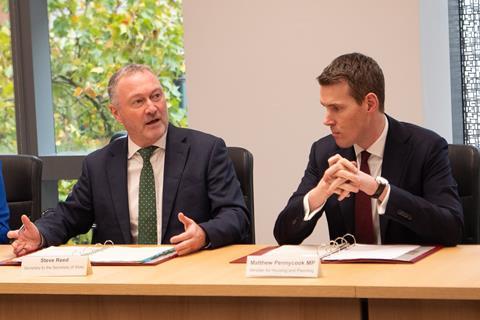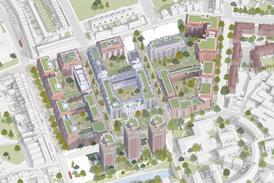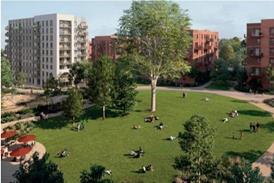Lord Gascoigne says current setup not strong enough
The minister responsible for delivering the new towns programme needs to be of “sufficient rank” to co-ordinate across departments and get the Treasury to “step up”, according to the chair of the House of Lords built environment committee.
Speaking to Housing Today last week, Lord Gascoigne suggested the current setup, a cabinet committee led by housing minister Matthew Pennycook, was not sufficient and expressed his preference for a senior minister working closely with No 10 to run the programme.

The committee published the preliminary findings of an inquiry into new towns last month, in anticipation of a major government announcement on its plans for the programme. That came around a week later, with the new towns taskforce identifying the 12 most suitable sites for development.
Housing secretary Steve Reed announced that work on three of these schemes - Tempsford, Crews Hill and Leeds Southbank - could be begun within this parliament.
Speaking ahead of the full publication of the committee’s findings, Gascogine, said the taskforce’s report was “unbelievably thorough” but that there remained a question mark around how the programme is paid for.
“For me, the one where there wasn’t answers […] was around the funding,” he said.
“Now it may be that there’s other funds that can be allocated to this, it may very well be that there’s something in the budget,” he acknowledged, but insisted that “there does need to be a demonstration that this is something that is going to get government support”.
>> Read more: Nicholas Boys Smith: New towns. Old wisdom?
>> Sector leaders welcome new towns announcement but warn of viability and infrastructure challenges
He said that the government’s housing ministers Matthew Pennycook and Baroness Taylor of Stevenage were “engaging and committed public servants”, but that they were “two voices in a very crowded field” within the government.
“The government’s created a cabinet committee, but in my view, it needs much more than that, and it needs to be really driven day in day out to see this agenda through,” he said.
The committee’s report said the programme required “strong and visible” leadership from a dedicated minister and Gascoigne expanded that this figure needed to be “of seniority enough to be able to bring people together” from across government.
“Personally, I’d say it needs to either be done through Downing Street or Cabinet Office of sufficient rank to make sure that you get, crucially, the Treasury to step up,” he said.
“Having been in Downing Street myself in a previous iteration, fundamentally, all power, all roads lead back to Downing Street”.
Gascoigne said the committee would continue its work on new towns.
“Now we have the locations, we’ll be able to do a lot of the assessments […] looking through the lens of these locations that have been announced,” he said.
The built environment committee’s report also recommended an infrastructure-first approach, a clear and “compelling national vision” for the goals of the programme, and the adoption of locally-led development corporations.
As part of his announcement last month, Reed promised to establish a ‘New Towns Unit’ to support public and private investment into the schemes, as well as fast-tracking development and working with architects to plan each town with its own distinct character.
The New Towns Taskforce’s 12 recommended sites
- A standalone settlement in Adlington, Cheshire East; to serve the growing industries in Greater Manchester and Cheshire, as identified in the government’s Industrial Strategy.
- A corridor of connected development in South Gloucestershire, across Brabazon and the West Innovation Arc; building in one of the highest productivity areas in the country with a high value research, advanced engineering and technology economy.
- An expanded development bringing together Chase Park and Crews Hill in Enfield; delivering green development and helping address London’s acute housing need.
- Redevelopment of the former airbase at Heyford Park in Cherwell; connecting to Oxford and building on the existing progress and commitment to high-quality placemaking; referencing the area’s past and supporting its future in innovative technology industries.
- Urban development in Leeds; catalysing on the city’s existing economic prospects and capturing the benefits of the governments £2.1 billion local transport funding allocation for the Combined Authority by delivering well-connected, high-quality homes in the South Bank to support the city centre.
- Inner-city development and densification in Manchester, Victoria North; supporting continued growth and attracting high-skilled workers to service the city’s diverse industries.
- A standalone settlement in the Marlcombe, East Devon; strengthening the region’s labour supply and supporting the Exeter and East Devon Enterprise Zone.
- A Renewed Town in Milton Keynes; reinvigorating the city centre and expanding to the city periphery whilst reshaping the way people travel, by delivering a Mass Rapid Transit system.
- Densified development in Plymouth; evolving Britain’s Ocean City and capitalising on the government’s £4.4 billion investment in HMNB Devonport, Western Europe’s largest naval base.
- A new settlement in Tempsford, Bedfordshire; to maximise the benefits of East West Rail, building a sustainable, well-connected new town in the heart of the Oxford-Cambridge Growth Corridor.
- The creation of a riverside settlement in Thamesmead, Greenwich; unlocking inaccessible land in the city and improving connectivity if the proposed extension of the Docklands Light Railway can be delivered to enable the development.
- Expanded development at Worcestershire Parkway, Wychavon; accelerating delivery around the existing train station to help meet regional housing need and act as a model for sustainable, carbon neutral development.
The government’s taskforce recommended a minimum of 40% affordable housing in the planned new towns, with half of this for affordable rent, and suggested that they should be delivered through development corporations with special planning powers to compulsory purchase land, invest in local GPs and schools, and grant planning permission.
The government welcomed these recommendations. It will now conduct a strategic environmental assessment of each of the 12 sites, as well as “any reasonable alternatives”.
The final new town locations and funding will be confirmed in Spring next year after these assessments and consultation.
















No comments yet